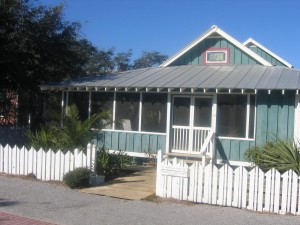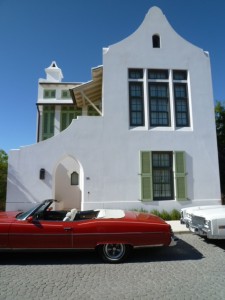I spent a weekend in Seaside, the emblematic small beach town that launched a thousand traditional neighborhood developments. Seaside is now more than thirty years old and looks it—in a good way. It is not merely a question of mature landscaping and weathered materials, but also of the indefinable small adjustments that take place when a place grows into itself. Unexpected things have happened, of course, not least a real estate bonanza. At Seaside, modest wood-frame houses on small lots regularly go for well over a million dollars. A beachside house designed by the late Aldo Rossi—nothing spectacular—is on the market for $11 million. And the town center is a runaway commercial success; it was crowded with people on a Sunday in November, which is not the high season in this part of Florida.
The architectural influence of Seaside is visible up and down Route 30A, the coastal highway, in houses, roadside eateries, even strip malls. There are also second generation Seaside-type resort developments such as WaterColor, Rosemary Beach and Alys Beach. They make an interesting comparison. WaterColor is a commercialized, scaled-up, mainstream version of Seaside. Both WaterColor and Seaside are riffs on a homegrown Southern vernacular: shady porches, shuttered windows, tin roofs. Think Thornton Wilder, Norman Rockwell, and Frank Capra. Rosemary Beach and Alys Beach, on the other hand, are spicier mixtures. Rosemary Beach is part Caribbean and—weirdly—part Bavarian, with rustic woodwork and steep roofs. Alys Beach is a combination Mediterranean village, Moorish coastal town, with a dash of Casablanca. Stucco walls, patterned tiles, wooden screens, hidden courtyards with trickling fountains. What started in Seaside as an earnest search for roots has turned into a fusion of exotic images that have little to do with a “sense of place,” or, at least with a sense of this actual place. That is unexpected, too.



